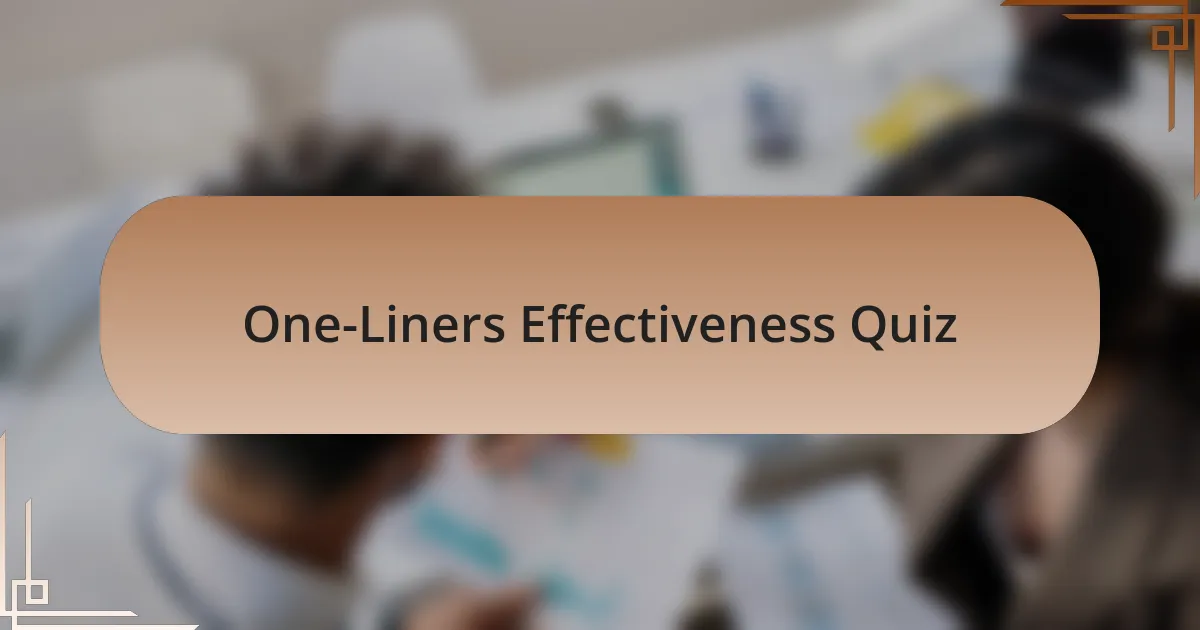Start of One-Liners Effectiveness Quiz
1. What has keys but can`t open locks?
- A phone
- A keyboard
- A suitcase
- A car
2. Why did the scarecrow get promoted?
- He couldn`t find his way home
- He was outstanding in his field
- He wanted to scare more crows
- He made everyone laugh
3. Why don’t scientists trust atoms?
- Because they are too small to see
- Because they always explode at parties
- Because they make up everything
- Because they break down frequently
4. What did my computer do when I needed a break?
- It froze like a deer in headlights.
- It took a power nap and forgot to wake up.
- I told my computer I needed a break, and now it won’t stop sending me Kit Kat ads.
- It started playing solitaire instead of working.
5. Why did the coffee file a police report?
- It spilled the beans
- It brewed a fuss
- It grounded itself
- It got mugged
6. Why do I carry a pencil in case of emergencies?
- To impress my friends with my art skills.
- Because it`s my good luck charm.
- It has eraser ways out.
- In case I need to draw a map.
7. What do you call a belt made out of watches?
- A “belted” hour
- A “timepiece” holder
- A “watch” strap
- A “waist” of time
8. How did I used to play the piano?
- I used to play the piano in my sleep.
- I used to play the piano with my nose.
- I used to play the piano by ear.
- I used to play the piano with my feet.
9. How does a penguin build its house?
- Builds it in the sky
- Flies it together
- Hammers it together
- Igloos it together
10. Why don’t some couples go to the gym?
- Because they prefer to binge-watch shows instead.
- Because some relationships don’t work out.
- Because they forgot their workout clothes.
- Because they can`t agree on a workout playlist.
11. What do parallel lines have in common?
- They love to travel
- They never meet
- They hold hands
- They always argue
12. Why don’t office chairs ever get tired?
- Because they have “bottomless” energy
- Because they take power naps
- Because they enjoy rolling around
- Because they’re always on the go
13. What did the clock do when it was hungry?
- It went back four seconds
- It struck a deal
- It set a timer
- It ticked too fast
14. Why don’t office supplies ever get in trouble?
- Because they prefer to stay neutral
- Because they don’t have any personality
- Because they always “stick” together
- Because they are always on the right desk
15. What do you call an IT teacher who touches the wrong buttons?
- A “bit” of a problem.
- A tech malfunction.
- An IT disaster.
- A keyboard warrior.
16. How do you make a document smile?
- You add happy fonts
- You “docu-smile” it
- You print a big grin
- You offer it some coffee
17. Why was the printer always running late?
- Because it couldn`t find its cable.
- Because it had too many paper jams.
- Because it was out of ink.
- Because it was stuck in a queue.
18. Why did the office scissors go to therapy?
- They were feeling a little dull.
- They had a cutting problem.
- They wanted to make sharper decisions.
- They couldn’t find their point.
19. What did the office plant say to the desk lamp?
- “You light up my life.”
- “I’m feeling a little green today.”
- “Let’s branch out together.”
- “Can you turn me on?”
20. Why did the pencil go to the dentist?
- It needed a “sharp” cleaning.
- It wanted to draw attention.
- It lost its cap.
- It was feeling dull.
21. What do you call a paper airplane that can’t fly?
- Heavyweight
- Aerodynamic
- Stationery
- Flapless
22. What’s an employee’s favorite movie?
- “The Pursuit of Happyness.”
- “Employee of the Month.”
- “The Office.”
- “Office Space.”
23. How does an employee stay cool under pressure?
- With a trusty “desk fan.”
- With a strong coffee.
- By counting sheep.
- By juggling tasks.
24. What do you call an employee who can’t make decisions?
- Pro-cras-tinator
- Decision-maker
- Time-keeper
- Over-achiever
25. How do employees deal with stress?
- They take up juggling.
- They sing karaoke in the break room.
- They meditate on spreadsheets.
- They practice “coffee-therapy.”
26. Why did the employee bring a plant to work?
- To keep an eye on the office.
- To decorate the break room walls.
- To “blossom” in their role.
- To compete with the office coffee.
27. What’s an employee’s favorite book?
- Moby Dick
- The Great Gatsby
- To Kill a Mockingbird
- The 7 Habits of Highly Effective People
28. How do you make an employee laugh?
- Ignore their requests for humor.
- Give them additional tasks.
- Offer them a flexible work schedule.
- Tell them a complex joke.
29. Why did the employee bring a magnifying glass to work?
- To see if the stapler was really out of staples.
- To look for the hidden snack drawer.
- To find the small details that matter.
- To magnify the coffee stains on the desk.
30. What did the employee say to the desk lamp?
- “You’re too bright for me.”
- “I can`t see you clearly.”
- “Can you dim your ego?”
- “You light up my day!”
Congratulations! You’ve Completed the Quiz!
Well done on finishing the quiz on One-Liners Effectiveness! We hope you enjoyed the process as much as we enjoyed creating it for you. One-liners are a powerful tool in humor, and you’ve now explored their impact in different contexts. From timing to delivery, you may have discovered just how much a well-placed line can resonate with an audience.
Throughout the quiz, you may have learned about the nuances of punchlines and the art of brevity. Effective one-liners rely on wit, surprise, and a pinch of cleverness. These elements can brighten a conversation or leave a lasting impression. Understanding these techniques can elevate your humor and make your interactions more enjoyable.
If you’re eager to dive deeper into the world of one-liners, we invite you to check out the next section on this page. There, you’ll find more insights and tips on mastering One-Liners Effectiveness. Expanding your knowledge in this area can help you wield humor like a pro. Happy learning and laughing!
One-Liners Effectiveness
Understanding One-Liners in Humor
One-liners are concise jokes or remarks designed to elicit laughter. Their effectiveness lies in brevity and punch. They can compress complex ideas into a single relatable statement. This student of humor often relies on wordplay, puns, or ironic comments. One-liners are popular in stand-up comedy due to their quick delivery and easy audience recall.
The Psychological Impact of One-Liners
One-liners have a unique psychological impact. Their brevity captures attention quickly, making it easier for audiences to engage. The surprise element in a punchline can trigger laughter by breaking expectations. This response is often linked to the release of tension. The succinct format also allows for clarity, which enhances comprehension and humor retention.
Contextual Relevance of One-Liners
Context greatly influences the effectiveness of one-liners. Humor changes with cultural norms and situational context. A well-timed one-liner can resonate deeply, while a poorly placed joke may fall flat. Comedians often tailor their one-liners to suit specific audiences, ensuring relevance. This adaptability is crucial for maximizing impact and audience connection.
One-Liners in Various Comedy Genres
One-liners play distinct roles across comedy genres. In observational comedy, they highlight relatable quirks of everyday life. In dark humor, they can address sensitive topics with sharp wit. Surreal or absurd comedy often relies heavily on absurd one-liners to challenge logic. Each genre utilizes one-liners to evoke specific emotional responses, enhancing the overall comedic experience.
Techniques for Crafting Effective One-Liners
Crafting effective one-liners involves specific techniques. Wordplay, such as puns, can create humorous twists. Conciseness is key; every word should serve the punchline. Building up a setup that leads logically to the punchline is essential. Additionally, practicing delivery enhances timing, which is critical for maximizing comedic effect. Strong one-liners often reflect unique perspectives, making them memorable.
What makes one-liners effective in humor?
One-liners are effective in humor because they deliver a punchy joke in a succinct format. Their brevity allows for quick delivery and immediate impact. Studies show that concise statements are easier to remember and can elicit laughter more effectively, as they engage the audience without lengthy setups. The surprise element in a one-liner often leads to an unexpected twist, which is a key component of humor. For instance, comedians like Steven Wright and Mitch Hedberg have utilized this format to great success, proving its effectiveness.
How do one-liners generate laughter?
One-liners generate laughter by creating anticipation followed by a twist. They set up an expectation and then subvert it with an unexpected punchline. This technique relies on the element of surprise and often utilizes wordplay, puns, or incongruity. Research in psychology indicates that humor often arises from incongruity, making one-liners a perfect tool for quick comedic relief. The immediate nature of one-liners means they can invoke laughter without a lengthy context, maintaining the audience’s engagement.
Where can one-liners be effectively used?
One-liners can be effectively used in various settings, including stand-up comedy, social media, and everyday conversations. In stand-up, they serve to build rapport and keep the audience engaged. On platforms like Twitter, where brevity is key, one-liners thrive due to character limits. In casual conversations, they can break the ice or lighten the mood quickly. Observational humor often incorporates one-liners to deliver insights or critiques succinctly. Their versatility makes them a popular choice across numerous contexts.
When is the best time to use a one-liner?
The best time to use a one-liner is during moments of tension or awkwardness. They can diffuse uncomfortable situations by introducing humor swiftly. Additionally, one-liners work well at the beginning of performances or speeches to capture the audience’s attention. Comedy studies suggest that timing is crucial; using a one-liner when the audience is most receptive maximizes its impact. Observing audience cues can help determine the perfect moment for delivery.
Who are notable figures known for their one-liners?
Notable figures known for their one-liners include comedians like Rodney Dangerfield, Steven Wright, and Mitch Hedberg. Rodney Dangerfield was famous for his self-deprecating humor and quick one-liners, such as “I don’t get no respect.” Steven Wright is recognized for his deadpan delivery of absurd one-liners like “I went to buy some camo pants but couldn’t find any.” Mitch Hedberg was known for his surreal and clever one-liners, exemplified by “I used to do drugs. I still do drugs, but I used to, too.” Their effectiveness in humor has solidified their legacy in comedy history.


